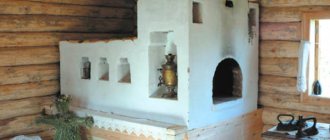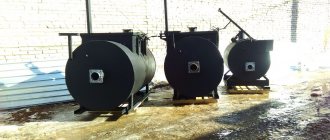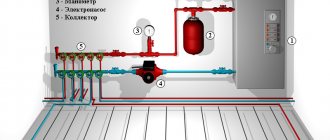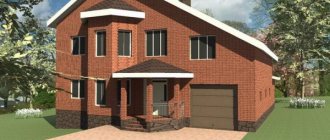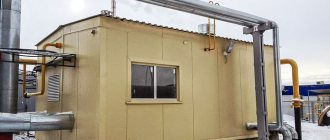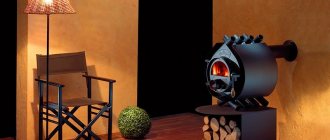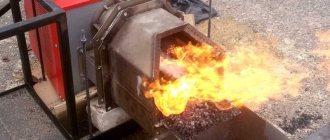What determines the choice of heating method for a summer house?
As a rule, a summer house is an object of periodic use, especially in winter. People travel outside the city to relax and enjoy clean air, and some even live in their dachas permanently.
The country houses themselves vary greatly - from light and poorly insulated to real cottages with several floors.
When choosing heating options for your dacha, you need to consider a number of important points:
- frequency and duration of stay in winter;
- what energy resources are available and will cost the least;
- distance from populated areas and organization of security of the holiday village;
- need for hot water supply.
In each case there may be additional nuances. For example, a dacha is combined with a bathhouse and it is more correct to provide one heat source for them. Or you have a large family, then you need to maintain a higher temperature in the rooms. The nuances must be taken into account when choosing a heating method.
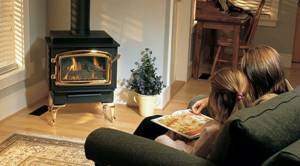
Particular attention should be paid to the issue of security; this is one of the features that distinguishes a dacha from an ordinary private house. Unfortunately, security in holiday villages is often poorly organized or non-existent, and burglaries are not uncommon. Imagine that you bought and installed expensive electric convectors, and they were stolen after you left. It turns out that the massiveness of the heat source plays an important role, so that it cannot be dragged away. These include heavy boilers, brick fireplaces, stoves, and so on.
Water heating
A common heating system can be water heating, because in this case water is heated in a stove or boiler. In all country premises, coolant circulates through radiators and pipes.
Boilers are classified into:
- electric boilers;
- operating on liquid fuel;
- gas;
- solid fuel.
Heating is quite effective, but of course it is also expensive. But this also has its advantages; you can come to the dacha around the clock. This version of the heating system is well suited for those who will often come to their dacha in winter, but if not, then you should think carefully about whether it is worth making such efforts and costs for this type of heating.
Heating system requirements
Depending on individual conditions, different requirements may be imposed on the heating of a country house, but there are also general ones that will always be relevant:
- quick heating of rooms;
- the heating system must use available energy carriers, possibly several;
- reasonable cost of equipment and installation work;
- efficiency and economy;
- the ability to function in periodic mode and withstand frost during downtime without consequences.
In order to make it easier for you to choose the optimal method of heating your dacha, we will consider real options for heating with different energy sources and how well they meet the listed requirements. Then you can add your wishes to them and determine which method is better.
Electric boiler
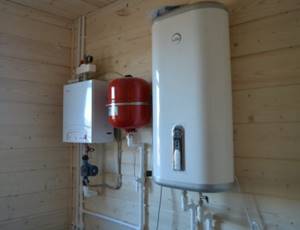
Unlike a gas system, an electric boiler is compact and easy to operate. There are different models of electric boilers. The power of the unit is selected depending on the area of the room. Electricity heats the air, then a pump pumps it throughout the heating system. Heated air constantly circulates in a confined space, heating the house.
If you place the boiler in the basement, it does not take up space in the house, but this is fraught with large heat losses. A lot of heat will be spent heating the basement. When planning a house, it is better to allocate a separate room for the boiler, adjacent to the residential sector. Thus, you will ensure high heat transfer with minimal heat loss and save electricity.
Electric boilers operate silently, do not emit any odor, and are easy to install and operate. The specifics of their connection should be taken into account. For example, if your boiler is low-power (3.5-7 kW), it needs to be allocated a separate branch from the distribution panel and installed automatic protection. A powerful unit (from 7 kW and more) is connected only to a three-phase network.
The only disadvantage of an electric heating system is its high price, but people often use it because of its convenience and ease of installation.
Electricity
At the moment, most holiday villages are not gasified, but electricity is available almost everywhere. Accordingly, electric autonomous heating without gas is of great interest and deserves consideration as one of the most affordable options. Its advantages are speed and low cost of installation, relatively low cost of equipment and reliability in terms of frequency of operation.
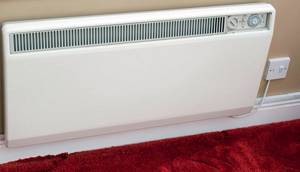
As for economy and efficiency, any electric heaters take first place in this regard. Their efficiency is 98-99%, which is higher than when burning any type of fuel.
The modern market offers a wide selection of means for heating a dacha with electricity. For well-guarded dachas or those where residents stay permanently, any of them are suitable:
- convectors and fan heaters;
- oil radiators;
- infrared heating systems;
- cable and film heated floors;
- water heating with electric boiler.
Electric fan heaters and convectors warm up the room the fastest, at least according to human sensations. Oil radiators take a little longer, but they also take longer to cool down. All these devices heat the air in the house and do not require installation, except for wall-mounted convectors. This household appliance can easily withstand the cold, and its maintenance comes down to periodic cleaning.

In an apartment, the light weight and size of an electric heater are an important advantage, while in an unguarded dacha this is a disadvantage; the devices are easy to steal. In addition, such electric heating will not provide the house with hot water, and for a certain part of people it causes discomfort and affects well-being.
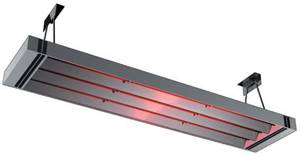
Infrared heating devices have the same disadvantages, only the higher cost of equipment and installation work must be added to them. The exception is portable infrared heaters, but they feel like they warm up rooms too slowly. To feel the heat emanating from them, you need to be in the radiator’s coverage area. On the other hand, infrared heating does not have a negative impact on human well-being.
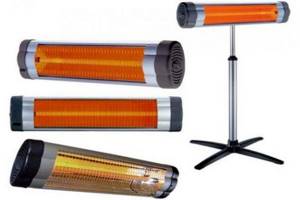
No. 3. Heating a country house with an electric boiler
The main part of an electric boiler is a heat exchanger, a tank with heating elements. They heat the coolant (water, antifreeze, oil), which circulates through a system consisting of pipes and heating radiators - everything, as is the case with a gas or liquid fuel boiler. In addition, the system often includes an expansion tank, a circulation pump and a safety valve. Induction and electrode boilers work somewhat differently.
The advantages of this heating method are obvious: no smoke and no need to install a chimney, quiet operation, safety, high efficiency (up to 99%), ease of operation and temperature control. Due to the high cost of electricity, such boilers are installed mainly when a country house is not used for permanent residence. In addition, do not forget about the need for good electrical wiring.
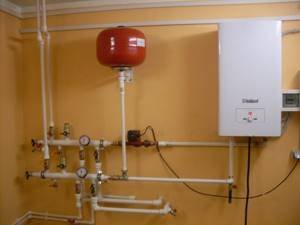
The following types of electric boilers can be used in the heating system:
- Heating element boilers are the simplest and most popular devices. The principle of their operation can be compared to a conventional electric kettle. Heating elements, of which there are usually 3-4 in a boiler, heat the coolant (water) in flow mode. Depending on the required temperature, the heating elements are turned on together, one at a time or in groups. Heated water circulates through the system, and for better pressure and circulation, circulation pumps are usually used. The power of such boilers ranges from 3 to 50 kW; there are models operating from a single- and three-phase network. Advantages of heating element boilers: compactness, low price, ease of installation. A significant drawback is the formation of scale on heating elements, which leads to increased energy consumption and gradual failure;
- Electrode boilers operate without heating elements. Their main part is electrodes. When current passes from one electrode to another through a liquid, the latter heats up under the influence of its own resistance. Antifreeze is used as a liquid. The power of electrode boilers is 5-25 kW. Such devices do not have the main drawback of heating element boilers - scale formation; they are compact, safe in case of water leakage and inexpensive. But they require mandatory water treatment, water must circulate strictly at a certain speed, and the electrodes gradually wear out and therefore require periodic replacement;
- Induction boilers also do not have heating elements, and heating of the electrical medium (water, oil, antifreeze) is carried out due to electromagnetic induction. These are the most economical boilers to operate, there is almost no scale formation in them, durability is excellent, but the purchase costs will be considerable, and the dimensions of such boilers are decent.
In addition, all boilers are divided into single-phase (consume 220 V voltage) and three-phase (380 V): the first are suitable for small houses and dachas that are visited from time to time, the second - for large dachas. Boilers are also divided into wall-mounted and floor-mounted, single-circuit and double-circuit (these also make it possible to organize hot water supply to the dacha).
As for the boiler manufacturer, to ensure reliability and durability it is not at all necessary to give preference to imported equipment - domestic products are better adapted to our operating conditions. By the way, craftsmen use a regular boiler in the heating system together with an electric boiler. It will cost even less, but there will be a few more problems.
Stationary heating means with electricity
Electric cable or film floors are perfect for heating a dacha. True, you will have to incur costs for the purchase of heating elements and installation under the floor covering or in the screed. But such equipment starts easily from subzero temperatures, and it is also impossible to steal.
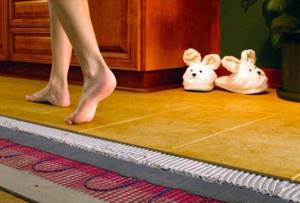
Disadvantages are long-term heating of the premises and the inability to heat water; this requires an electric boiler or a separate water heater.
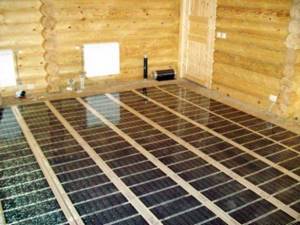
The most convenient and functional traditional heating method is a water system with an electric boiler as a heat source. Its negative aspects are significant financial costs for installing the system and a long heating time for the building. In addition, during your absence, the water system is in danger of defrosting. But by installing a small indirect heating boiler in addition to the boiler, you can get hot water for household needs at your dacha.
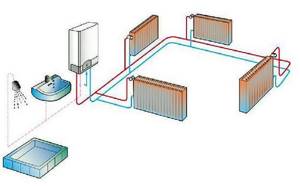
To avoid defrosting, you need to purchase antifreeze, and use it to prepare and pour liquid into the heating system.
Important disadvantages of electric heating in general are the high electricity tariff and the limited power consumption limit. Regarding various heaters, you could see for yourself that they all have pros and cons; the appropriate option is selected individually.
Heating options for cottages: selection criteria
If the owners plan to use the dacha in winter, then they will have to think about how it will be heated. In order to wisely choose heating options for your dacha, options for which you can spy on the Internet, you need to consider some of them and determine which one is most suitable for a particular home.
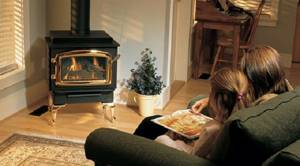
Cottage heating options
If previously there were only two options available for use in suburban conditions - a wood-burning stove or electric heaters, provided that electricity was supplied to the dacha, today the choice of ways to heat a dacha house is much wider.
In addition, every owner of a country house, who has a little imagination and certain knowledge, can independently figure out how to economically and efficiently heat a home using one or more methods, combining them with each other. Perhaps a consideration of the heating systems below will help someone make a choice from ready-made solutions or even design their own innovative option.
Heating selection criteria
First, you need to decide what functions heating devices should perform, since sometimes simply heating rooms in a summer cottage is not enough.
- The main criterion, naturally, should be efficient heating of the house, maintaining a comfortable temperature in the premises in any weather.
- For comfortable living, it is advisable to consider heating the bathhouse (if there is one) or heating water for the shower.
- Cooking and boiling water for food needs - brewing coffee, tea, etc.
- Drying wet clothes and shoes, which is especially important in inclement autumn or winter weather.
- Drying vegetables and fruits for the winter.
Having identified the functions that you would like to have in combination with heating, you can move on to considering its various options.
Heating system powered by a boiler
It is advisable to install a heating system that uses a coolant heated in a boiler and supplied to radiators for heat exchange in a dacha if it is used for housing all year round. At the same time, you need to remember that very often you will have to go through all the authorities to obtain permission, draw up and approve a system installation plan, so you immediately need to estimate the cost of not only purchasing all the necessary equipment for installation, but also completing the documentation.
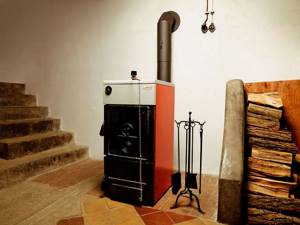
From a convenience point of view, the best option is heating using a boiler
Selecting a heating boiler
The choice of heating device depends on several factors:
- Availability of the necessary source of fuel or energy carrier on the site. For example, if a gas supply is connected to the dacha, then the most optimal option would be to choose a unit that runs on gas. In addition, boilers are produced that can operate on electricity or on solid or liquid fuel, as well as mixed-type heating devices in which, if necessary, the energy carrier can be replaced by one another.
- The area of the heated premises, that is, it is necessary to determine the required power of the unit. To do this, calculate the amount of thermal energy required to heat 10 m² of a house. This parameter, of course, largely depends on how insulated the building that is planned to be heated is, and with high-quality thermal insulation, you can start from the proportion of 1 kW of energy per 10 m², with an average ceiling height of up to 3 m.
If a country house has thin walls without thermal insulation, then heat will not be retained in the house for a long time with any type of heating and with any boiler power. The funds spent on the purchase and installation of all elements of the system, as well as on energy resources, will simply be thrown away.
- Availability of space for installation of equipment, since some boilers necessarily require a separate room or a reliable base due to their technical characteristics.
In specialized stores you can find for sale not only floor-standing heating boilers, but also wall-mounted ones, which are small in size.
As a rule, compact wall-mounted options do not have excessively high power, but if the country house is small and well insulated, then it is possible to choose such a boiler with suitable parameters.
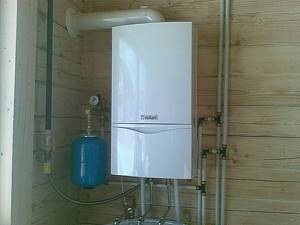
Boiler placed on the wall
Floor-standing boilers have massive shapes and are quite heavy. For them, it is necessary to prepare a special solid platform or even make an extension to the house in which the boiler room will be located.
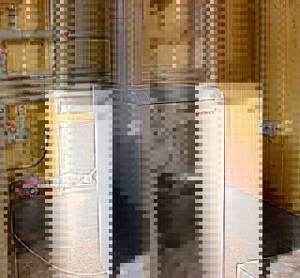
More powerful units are usually floor-standing
- Any boiler (except electric) requires a chimney. Its specific structure and parameters will depend on what fuel the unit runs on and what its power is.
- Its price will largely depend on the type and power of the heating installation.
It is worth considering in more detail the positive and negative aspects of units operating from different energy sources. First, about the obvious advantages :
- A boiler running on natural gas is quite economical, has high power and is reliable in operation.
- Solid fuel boilers do not require additional connection to the gas mains or to the power supply system (if they are not equipped with electronic automation). Solid fuel in many regions of the country is much more affordable compared to electricity and gas. In addition, such boilers can often use various types of fuel - coal, firewood, peat briquettes, pellets.
- Electric boilers have a relatively low cost, are compact in size, and are also easy to install and do not require special intervention during operation. (more details about the features of electric boilers can be found in the hotel publication of the portal).
Now let’s “go through” the disadvantages of various units:
- The obvious “disadvantages” of installing a gas heating system include the expensive procedure for drawing up a plan and directly connecting the gas supply, which requires numerous approvals. In addition, not every dacha village has a gas pipeline yet.
- A boiler running on diesel fuel requires a large volume of it. And although diesel fuel has a relatively affordable price, a problem can be created by the lack of capacity to store at least a minimum reserve. In addition, the fuel itself has a specific odor, which intensifies when it burns. Another big disadvantage of such units is the loud noise during operation, so you cannot do without an additional separate room for an oil-fuel boiler.
A modern diesel boiler cannot operate without consuming electricity (albeit minimal), which means that if there are frequent interruptions, then you need to consider a backup uninterruptible power supply.
- A solid fuel boiler needs to be loaded fairly frequently, and fuel reserves require an appropriate location and conditions.
- An electric boiler (with the exception of induction ones) is not very durable, and, naturally, is completely dependent on the availability of electricity. Unfortunately, in holiday villages, complete power outages or surges with large voltage amplitudes are not at all uncommon. Therefore, in this case, it is imperative to have an alternative, non-electric heating option, which will inevitably entail additional costs.
For ease of perception, a table is provided that summarizes some of the distinctive features of various types of heating installations:
| Characteristics | Room heating method | |||
| A gas boiler | Liquid fuel boiler | Electric boiler | Geothermal heat pump | |
| Equipment cost (price) | average | average | low | high |
| Boiler room area for installation of equipment in sq. m | 6 | 6 | 3 | 6 |
| Energy source | Natural gas | Diesel fuel | Electricity | Electric current and heat of earth, water, air |
| Energy costs | average | big | very big | The heat of the earth is unlimited and free, electricity costs for equipment operation are minimal |
| Lifetime | 15-20 years | 15-20 years | 5-8 years | Up to 50 years |
| Fire hazard of the boiler during its operation | dangerous (constant fire) | dangerous (constant fire) | dangerous due to the possibility of shorting the wiring | safe |
| Explosion hazard | dangerous | dangerous | safe | safe |
| Level of environmental hazard during operation | harmful, emits CO and NOx | harmful, emits CO and NOx | harmless | harmless |
| Ventilation | necessary | necessary | need not | need not |
| Service | regular inspection | regular inspection | inspection if necessary | inspection if necessary |
| Reliability | high | high | high | very high |
| Autonomy in the absence of energy supply | backup power supply required | backup power supply required | does not work | works with a backup electric generator of 6 kW |
| Possibility of room cooling | does not provide | does not provide | does not provide | provides |
Combination boiler
Separately, it is worth saying a few words about the combined type of boiler, which can, if necessary, switch from one fuel to another.
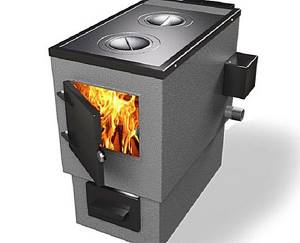
Combination boilers have increased versatility
The options here can be different: “wood - gas”, “wood - electricity”, “liquid fuel - electricity” and others. This can be very convenient - if, for example, the power goes out, then the boiler can be continued to be heated, say, with wood or peat briquettes, or switched to diesel fuel. Sometimes combination boilers have special replaceable or built-in burners and are equipped with a hob, which can be simply irreplaceable in country conditions. Therefore, it is often the combination boiler that becomes the best option for a country house, provided that the place for it is properly prepared.
Any of the modern combination boilers has a built-in automatic system that monitors the health of the unit, fuel supply and controls its operation. For example, if the boiler was heated with solid fuel, and it burned out, and the temperature in the heating circuit dropped below the set value, electric heating is switched on.
Hot water supply
At the dacha, you also cannot do without hot water - if you live there permanently, then it is simply necessary for daily hygienic needs. Of course, in the summer you can use a summer shower, where the water is completely heated by the sun’s heat, but in winter this option is not suitable. If you don’t want to heat water on a hob the old fashioned way, then it is best to install a double-circuit boiler when installing heating, which will not only provide space heating, but will also supply hot water for a variety of needs.
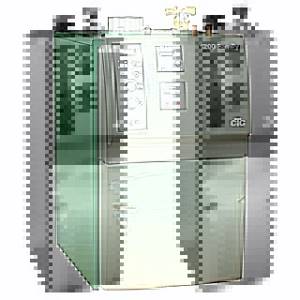
A double-circuit boiler will provide both heat and hot water
You can use another option - this is a single-circuit boiler with an indirect heating boiler attached to it. In this case, a pump is built into the system, since the force of natural circulation of the coolant will not be enough. This option requires quite a lot of space to install all the necessary elements, so it will be necessary to allocate a room for this purpose or make a small extension.
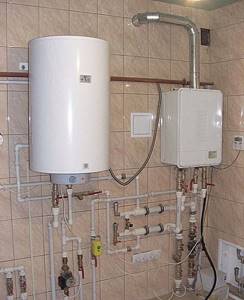
Boiler in conjunction with an indirect heating boiler
In any case, if you decide to use a boiler for heating, you need to carefully consider all the nuances, and when purchasing it, carefully study the characteristics and clarify unclear information from the sales consultant.
Prices for the range of heating boilers
Heating boilers
Video: recommendations for using boilers in the country
Geothermal heat pump
In the comparison table above, the rightmost column is occupied by the characteristics of the heat pump. There is currently a lot of talk about it as an alternative source of thermal energy. Since this heating method is not as popular and well-known as heating from a boiler, it is worth devoting a few lines to it.

External units of geothermal installation
A geothermal heat pump is a system for creating a microclimate in a house, which operates from the heat of the earth.
At its core, it is a kind of air conditioner with two circuits - an evaporator and a condenser. In winter it works as a source of heat, and in summer it produces coolness. The process occurs due to the difference in soil temperature at different depths, and to increase the efficiency or reduce the costs of the cooling and heating system, a geothermal pump can be used in conjunction with heating a house using solar energy.
The operation of geothermal heat pumps is based on thermal inertia, since the temperature of the earth at a depth below 6 m is approximately the same as the average annual air temperature in the region, and it practically does not change regardless of the season.
In addition, there are similar systems that can use the thermal energy of air or water.
- “Earth-to-water” is the most common type of heat pump, which extracts heat from the ground using coolant circulating through pipes buried in the ground, and then, after conversion, transfers it to heating devices.
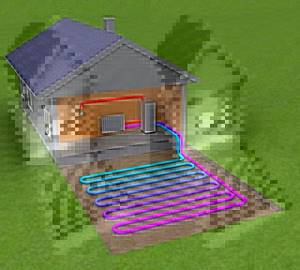
Use of earth's thermal energy
- "Water-to-water" - this type of pump obtains heat from water, in which case the primary heat exchanger is immersed in a natural body of water, or a deep well is drilled for the probe to reach groundwater.

A body of water or an underground aquifer can be used as a heat source
- “Air-to-air” - a heat pump operating on this principle receives energy from the air. This option does not require excavation, drilling wells or the presence of a nearby body of water. The energy is obtained using a probe block that uses the temperature amplitude of the surrounding air. All the main elements of such a system are located inside the building, which eliminates the risk of damage.
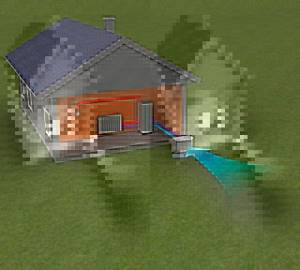
We learned to use the thermal energy of air
Heat pump prices
Heat pumps
Cost-effectiveness of a geothermal heating system
A home heating system using a heat pump will justify the cost of its installation only after several decades. It cannot operate on its own and will require electrical energy to keep it functioning. So, to produce 10 kW of thermal energy, the heat pump will need to consume 2.5 ÷ 3 kW of electricity, that is, the net gain will be in the region of 7 ÷ 7.5 kW, which, in principle, is not so small. However, if you look at this issue from the point of view of payment, then it turns out to be not much cheaper than when operating a conventional electric boiler, but the material costs of installing these devices are simply incomparable. In addition, to install a system with a heat pump, you need to do a tremendous amount of work, but an electric boiler is connected quickly and easily.
If there are frequent power outages in the village where the country house is located, to operate the geothermal heating system it is necessary to provide a backup power source - a generator running on a different type of fuel with a power of about 6 kW. The purchase and permanent installation of such a power unit will also lead to considerable costs.
To sum it up, we can say that this way of heating the house is without a doubt environmentally friendly, and it has a very bright future. But its current economy must still be questioned. Therefore, before taking on such a business, it is worth making careful calculations and soberly assessing the profitability of such an undertaking.
Infrared heating of the cottage
This type of space heating is based on the use of special infrared emitters or infrared film as a heat generator. This method of heating a house can be used both as the main and as an auxiliary one, in combination with other types of heating.
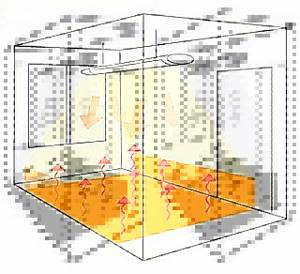
Operating principle of an infrared heating system
The principle of operation of infrared heating is that the heater transmits radiant thermal energy in the infrared range (by analogy with the thermal energy of the Sun) to all surrounding elements of the interior, as well as the floor and walls, and they, in turn, when heated, conduct a wide-area heat exchange with air.
It should be immediately noted that this type of heating of a country house will be effective only if all elements of the building - the ceiling, walls, floor, windows and doors - are well insulated. If this condition is met, then heating using infrared radiation will achieve the following results:
- Create a comfortable microclimate, that is, temperature and humidity in the premises corresponding to the normal well-being of residents.
- Ensure the most favorable temperature distribution across the height of the room.
- Preserve clean air, since with this method there is no intense air circulation, horizontal convection currents, especially along the floor, which always carry a lot of dust with them.
Infrared heaters
This type of heater is fixed to the ceiling, at a height of 2.3 ÷ 3.5 m, usually in the center of the room. The main thing to take into account is that the residents of the house are not constantly located directly under them, that is, they should not be hung above a bed, dining or desk, children’s play area, etc.

Ceiling infrared heater resembles a regular lamp
It is not recommended to mount infrared heaters on ceilings lined with PVC panels or close to windows, as heat loss in this case will increase.
Infrared film
In addition to heaters with infrared radiation, special film elements can be used to heat a country house, which are placed both on the ceiling and on the walls and floors.

Another option is film IR emitters
The film can be placed under various decorative coatings. So, on the floor it can be parquet or linoleum, carpet or laminate, on the walls - ceramic tiles or wooden lining, on the ceiling - plasterboard or the same lining.
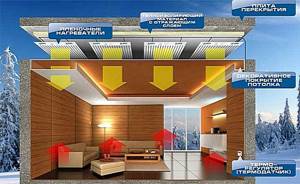
Possible layout of infrared film heaters
However, there are some limitations. For example, you cannot install infrared film on the ceiling; you plan to decorate it with fabric. It is incompatible with suspended ceilings, PVC panels or materials containing metal (for example, foil).
Advantages and disadvantages of infrared heating
This type of home heating has its positive and negative sides. You need to know about them before choosing this particular option for installation in your dacha.
Advantages of IR heating
The “advantages” of using infrared heating include the following:
- Providing heating of the room in a short time after turning on the system, since surfaces quickly heat up and give off heat to the air.
- The heat obtained in this way does not dry out the air at all, so the rooms maintain the required level of humidity.
- The system does not make any noise when operating.
- The temperature in the room can be maintained at the desired level by very accurately setting the desired temperature using a thermostat.
- The infrared system is not afraid of voltage surges, which often happens in holiday villages.
- Installing the film is quite simple and quick, so you can easily handle this work yourself.

Installation of infrared film heating can be done on your own
- The system does not require preservation for the winter - it only needs to be turned off from the network. When you arrive at your dacha in winter or early spring, you can be sure that the house will not be cold at night. All you have to do is plug in the system and literally within half an hour the house will have an acceptable temperature.
- In addition, if such a need arises, the film can be easily dismantled and moved for installation in another room or building.
- The system is easy to operate and does not require maintenance.
- Long-term operation - manufacturers guarantee that with proper installation, such elements will last for several decades.
Negative qualities
It would seem that after so many advantages, one can not even pay attention to the negative aspects, since they should be completely insignificant. However, unfortunately, this is not entirely true.
The “disadvantages” of infrared heating include:
- If electricity is often cut off in a holiday village, then an infrared heating system alone will not be enough. In this case, it is necessary to additionally have an option that operates on a different type of energy.
- This type of heating is not as economical as manufacturers advertise it. For example, for 1 m² of area, depending on the quality of insulation and the height of the ceilings of the room, you may need from 5 to 20 W, and for a house with an area of 100 m², at least 700 kW will be required per month. Therefore, before purchasing and installing film, you need to make careful calculations of your real capabilities.
If the reader would like to find out more detailed information about the calculations and installation of infrared heating , then this can be done by following the recommended link to a special publication on this topic.
Stove heating
Stove heating can be called the most reliable. It is widely used both as the main type of heating at home and as an auxiliary one. The stove does not require connecting mains for energy - the homeowner himself must take care of the fuel in advance. If a supply of firewood or coal is prepared on time, warmth in the house will be ensured. If there is no electricity supply at the dacha, the stove will not only heat the house, but also “feed” the whole family, as it often allows you to cook lunch or dinner, heat water and even bake bread.

The traditional way of heating a dacha is a stove
Depending on the area allocated for the stove, you can choose the appropriate model, size of the stove and material for its manufacture.
You can build a traditional brick oven - it may well have compact dimensions and an aesthetic design. Or there is the opportunity to purchase a ready-made version, made of cast iron with or without stone trim.
In addition, both brick and cast iron stoves can have several options for their functionality:
- A heating system that will only warm the house.
- A heating and cooking option that has a hob, oven and even a hot water tank, allowing not only to cook food, but also to satisfy the need for hot water.
- A fireplace stove, which can be either simply heating or have a stove and oven, and at the same time create a very special coziness in the room.
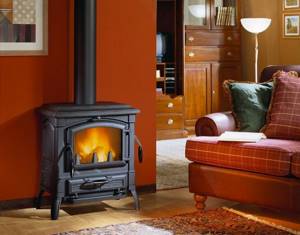
Cast iron stove-fireplace
"Pros" and "cons" of stove heating
If you decide to choose this particular option for heating a country house, you need to familiarize yourself with the negative and positive aspects of using stoves
Advantages of stove heating:
- Complete autonomy and independence of the system from external factors.
- Affordable fuel price. If there is a forest or forest plantation in the area of your summer cottage, then during the summer you can make a supply of firewood from fallen trees and dry branches - in this case, you will get fuel for nothing.
- The profitability of this type of heating is undeniable, since it will cost several times less than a boiler running on gas, electricity, or diesel fuel.
- If the oven is well maintained, it is always ready for use. In the case where the cottage is mainly used only in the summer, there will be no problems with freezing of the equipment, since the stove will not be affected by low winter temperatures.
- The ability to cook food and heat water are functions that are always necessary in suburban conditions, and which are not inherent in all heating systems.
- If you choose a cast iron unit, it will not take up much space, and the site itself will not require labor-intensive preparation, since this version of the furnace is not as massive as one built from brick.
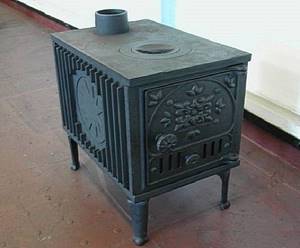
Compact cast iron stoves take up very little space
- It is quite possible to install a cast iron stove yourself.
Negative points in using stove heating:
- Stove heating requires constant monitoring during its operation, as well as periodic, fairly frequent loading of fuel.
- A cast iron stove without a water circuit will not be able to heat more than one room.
- The efficiency of stove heating is significantly lower than when heating a house with a boiler. If the average efficiency of even not the most “sophisticated” devices reaches 80%, then for stoves it is only 50 ÷ 60%.
- Any stove requires periodic maintenance, more frequent than a boiler, since to create good draft, on which the efficiency of its operation depends, annual monitoring of the chimney and its regular cleaning are needed.
- There is no need to build a separate room for the stove, but if you choose a brick stove, it will take up quite a lot of space. Although you can get out of this situation by placing it between rooms, by building it into the wall.
- It will be quite difficult to build a brick oven yourself, since this requires special knowledge, skills and dexterity in work.
more about the stove heating option from a special article on the portal.
Prices for fireplaces and stoves
Fireplaces and stoves
Video: a very original option for heating a dacha from one stove
If the publication helped the reader at least preliminary decide on the choice of heating system for the dacha, then that’s great. But don’t rush to leave the pages of our portal! Go to the section on stoves and heating systems - there are detailed explanations and practical guides for calculations and installation for each type.
Without a doubt, everyone will be able to find the best option for themselves.
Gas
Of course, gas heating is one of the most convenient for a dacha; there will be quick heating and hot water. The efficiency of the installations is high, reaching 92%. But the price of the resource varies greatly in different countries. In the Russian Federation, heating a dacha with gas is realistic, in Belarus or Ukraine it is already problematic, where its price is much higher. And gas mains are not laid in dacha cooperatives, with rare exceptions.
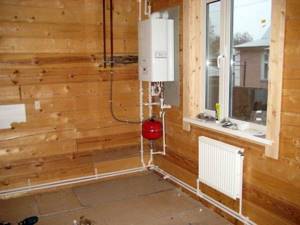
When the house is gasified, heating in the dacha can be done in two ways:
- install a double-circuit boiler and mount pipelines with radiators;
- install gas convectors in the premises, thereby organizing air heating.
The main difficulty when installing gas heating is obtaining permission to connect to the main line. Carrying out the procedure in relation to a country house is not economically feasible. The solution is to heat with liquefied gas, but this only makes sense in Russia, where the price of fuel is acceptable.
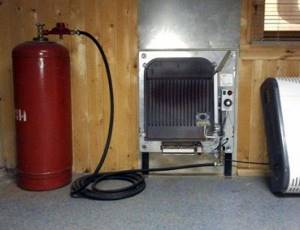
Stove heating of a country house
Its use is especially advisable if the house is located away from the central gas pipeline lines. As advantages, we can note the use of renewable energy sources, and if it is simpler, firewood and coal, this is especially true if there is a sawmill near a populated area, where wood waste from production can be purchased at a much lower price than simple firewood.
A well-installed stove is extremely durable and reliable, and most importantly, it is multifunctional, here you can heat water and cook food, and it smells something familiar, because our great-grandfathers used this type of heating at home. One of the disadvantages is the cost of building a stove, especially if you build one that is large enough in size, plus it takes a long time to heat up. But all these disadvantages can be compensated for by purchasing a portable wood-burning stove; it heats up quickly and is not so expensive, but it does not inherit all the advantages of a stone stove, so it is a double-edged sword.
Types of stoves
Oddly enough, stoves have their own classification according to the type of heating, which will be discussed below.
- The first type is hydrolysis; such furnaces consist of two combustion chambers. As a heating option it is great for large houses, why? It's all about the design, in which not only the burning of wood is used to produce thermal energy, but also the hydrolysis gas released during this process. The secret is that pressure is artificially built up in the furnace, and as you know from a physics course, the greater the pressure, the higher the temperature, and so it is here. When the damper is closed, through which oxygen enters the combustion chamber, a special pump forces air into the furnace, increasing the pressure, in this simple way hydrolysis gas is formed, and the temperature increases noticeably.
- Next come the convection-type ovens; they use a simple operating principle: at the bottom of the device there is a hole through which cold air enters the unit. Further, while the cold air passes through the oven, its temperature rises, and through the upper hole it is exhausted into the room. A good option, considering that it is relatively inexpensive and also heats the room due to its own heating. But there is also a serious disadvantage: along with the warm air, combustion products are released into the room, which can negatively affect human health. But if you use it during, say, a weekend visit to the dacha, then there is nothing to fear.
- Furnaces with the scientific name heat-generating operate on the basis of smoldering. The loaded residues are burned and then left to smolder in oxygen-free mode. Since the smoldering operation itself releases the thermal energy of the substance in a small but uniform amount, heating the room takes longer, but at the same time cools down more slowly, although the minus is debatable, since in the cold season it is also a plus. Well, fuel, for a stove of this type can be represented by almost any wood waste.
Single-chamber ovens are, one might say, an economical option. The fact is that its efficiency is the lowest among all its competitors, but there is a powerful plus, this is the cost. It is thanks to their low price that they are quite widespread and in demand. The principle of operation is simple, like everything ingenious, the pipe with air passes extremely close to the combustion chamber, from there and that’s it, warm air is ready for the house.
The open type of stoves, in addition to heating, has an important decorative role, often these are fireplaces, of course their efficiency is not so great, but aesthetically the fireplace looks very impressive. No stove will give you a cozy evening with a cup of tea and the dim light of dying wood. Although you can’t cook food on it, which is undoubtedly a minus.
Now let's weigh the pros and cons
BEHIND:
- Good heating of rooms
- Mobility (except stone oven)
- Autonomy (throw the wood in and forget it)
- Multifunctionality (here is a stove and everything else)
AGAINST:
- Fire hazard (especially for portable ones);
- The need to stock up on firewood and find a place for it;
- Place for the stove itself, chimney lining.
Stove and solid fuel boiler
Heating your dacha with wood is the easiest thing to do if you are not in the desert. There is no need to obtain any permits, and it is impossible to drag away bulky equipment. Both the stove and the boiler feel normal at low temperatures, this is important for periodic use. An exception is boilers equipped with electronic control units; this modern technology may fail when started in cold weather. So it is better to organize heating of a country house with a solid fuel boiler of a simple design, without electronics. The efficiency of such units does not exceed 75%.

The heat generator, as in the case of gas, will have to be connected to a water heating system, filling it with antifreeze. At the initial stage, count on a significant investment of money, since equipment, piping elements and heating devices with pipelines will not be cheap. When the house is small, this is irrational; it is better to organize stove heating. The choice of metal stoves is extremely wide; you can choose the right one both for money and for every taste.
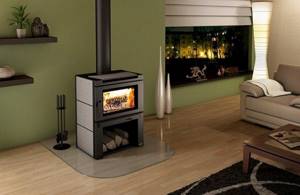
Metal and brick stoves with water heating quickly heat up themselves and warm up the room; in addition, they can supply heat to radiators in adjacent rooms, as well as prepare water for hot water supply. But the efficiency of the furnaces is low - about 60%.
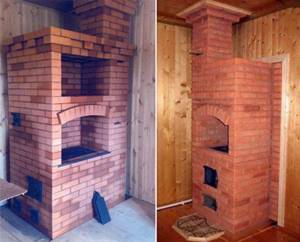
Building a brick stove is not always expensive; here you need to choose a successful design, for example, build a Dutch stove or a small Swedish stove. It can include a hob for cooking, an oven and a water tank. For aesthetes, we can advise you to build a fireplace out of brick or purchase a ready-made metal one.

Despite all their advantages, stoves and fireplaces require chimneys and also take up a lot of space. A solid fuel boiler can be taken outside into an extension, but the stove will take up useful space in the house.
Option for heating a dacha with an electric boiler
Quite a common option. Has many advantages:
- There is no need to allocate special rooms for firewood, coal, pellets or anything else and, accordingly, deal with the preparation of all this;
- A house with an electric boiler is always clean, because there is no need to put combustion products into it and then remove the ash, so the boiler can even be placed in the kitchen;
- An electric boiler takes up little space, so it can easily be placed in any living room or bathroom;
- There is no need to build an expensive chimney and subsequently maintain it;
- There are many possibilities for installing various control units, from a simple GSM module for turning on the heating via SMS, to control via an application on a smartphone.
Heating the cottage with an electric heating boiler. House area 95 sq.m.
Cost of work: 39,500 rub.
Cost of materials: 46,555 rub.
More details
The main disadvantage of this type of dacha heating is the rather high cost of electricity, as well as its interruptions and blackouts. In many areas, surges and sags in the power supply network are also observed.
In order to be able to comfortably use electric heating, as well as to simultaneously use other electrical appliances, of which there are a great many in a summer cottage, the power supplied to your site must be at least 15 kW.
Diesel fuel
This case is appropriate if the owner of the dacha no longer has any energy resources at his disposal. This really happens, diesel heating comes to the rescue when there is no gas, the limit on electricity consumption is too small, and transporting firewood is too far or expensive. The cost of the equipment is comparable to gas, as is the efficiency (92%), only connection permits are not required. This is where the positive aspects end, the reason is the price of diesel fuel, the operation of a diesel boiler cannot be called cheap.
To heat a dacha with diesel fuel, in addition to the boiler, you still need the same water heating system and radiators filled with antifreeze. The water heating function is also available if you purchase a dual-circuit heat generator. A warning is appropriate here: it is better to take the unit with a minimum of electronics, which can fail at subzero temperatures.
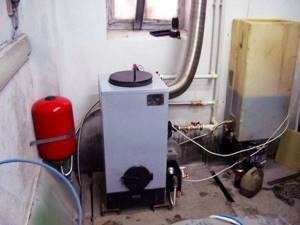
For those who like to do the heating installation themselves, there is an alternative: a homemade boiler using waste oil. You can make it yourself, spending a minimum of money. The game is worth the candle, provided that such fuel is available to you.
Electric heating
Gasification has not yet touched all corners of our country, but there are usually no problems with electricity: it is available in almost any area. To be fair, it should be said that electricity is not the cheapest option for heating a home. This is compensated by its availability and compact dimensions of electrical appliances. Modern electrical equipment fits seamlessly into the interior of the dacha. As for installation, care and maintenance, this does not require much time or special skills.
There are the following options for heating a country house with electricity:
- Installation of an electric boiler and a water circuit with water heating.
- The use of individual electric heaters for each room in the house.
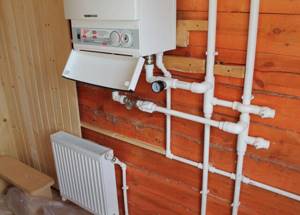
The principle of operation of electric water heating is similar to gas heating: after heating in the boiler, the coolant flows through the system to the radiators thanks to the circulation pump. The way electric heaters, fan heaters, infrared emitters, convectors and oil heaters function is familiar to almost everyone.
Achieving stable and efficient heating of a dacha with electric heaters is problematic. To do this, you need to turn them all on at the same time, which will lead to increased energy consumption. A more economical option is to install an electric boiler and water heating. It can be equipped with both conventional water batteries and a “warm floor” system. This is especially true for situations where the dacha has a basement and attic. The efficiency of such heating will be in no way inferior to gas heating.

Good electric boilers have a number of strengths:
- Quiet operation, during which no smoke, combustion products or unpleasant odors are emitted
- Easy to install, no special government permits required.
- Completely environmentally friendly and harmless to the environment.
- Automatic monitoring and control of the operation of the device, which does not require human presence.
- Absolute safety.
Related Posts
- Economical heating of a private house and apartment
- How to make steam heating
- Heating a house without gas or electricity. possible options
- A supply of hot water that is always at hand: how does an electric water heater for heating work?
- Installation and installation of a solid fuel heating boiler
- Connection diagrams for bimetallic radiators
- Leningrad heating system for a private house
- Do-it-yourself air heating: everything about air heating systems
- Choosing between metal-plastic and polypropylene pipes
- Benefits of using a duct extension for radiators
- Wood-burning stoves and their variety of designs
- How to make geothermal heating at home
- Do-it-yourself heating installation in a private house
- Types and principle of operation of a gas boiler for heating a private house
- Do-it-yourself gas heater: options for the best homemade products
- At what temperature of the coolant is the heating system turned off and turned on in an apartment building according to GOST
- Pipe box
- How to build a country house with your own hands: plans and designs of finished houses (+photos)
- An affordable alternative to traditional heating
- What to do if the bottom of the battery is cold and the top is hot?
- Hydroarrow: principle of operation, purpose and calculations
- A selection of projects for houses with stove heating
- Connecting and calculating a buffer tank to a solid fuel boiler
- Which pipe to choose for heating
- Thermal accumulators for autonomous heating systems
Read with this
- Economical heating of a private house and apartment
- How to make steam heating
- Heating a house without gas or electricity. possible options
- A supply of hot water that is always at hand: how does an electric water heater for heating work?
- Installation and installation of a solid fuel heating boiler
- Connection diagrams for bimetallic radiators
- Leningrad heating system for a private house
- Do-it-yourself air heating: everything about air heating systems
- Choosing between metal-plastic and polypropylene pipes
- Benefits of using a duct extension for radiators
Types of heating systems and units
Which heating system for a country house to choose, which energy carriers will work in the circuit, how to install and use heating, depends on an extensive list of factors. These include existing utilities (gas, electricity, water supply), and the layout of the premises in the house, and the building materials from which the house is built, and the number of residents, and the frequency of visits to the house in winter. Even the type of foundation affects the effective heating of a summer house in winter.
There are several options for heating systems that are offered to the consumer depending on the energy resources that can be used in the house:
- Heating is on gas;
- Heating by electric appliances with or without water heating connection;
- Conventional wood (coal) stove, fireplace;
- Liquid fuel or solid fuel heating units at the dacha in winter;
- Universal heating boilers.
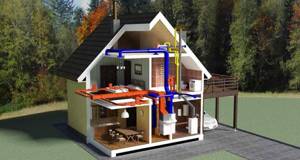
Country heating in a 3-D project
